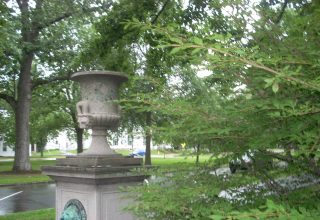
When he first introduced the idea of numinous, Otto was focusing on profound religious experiences. Jung, however, described the numinous in much broader terms. In what some scholars identify as the first “psychological” analysis of religious experiences, Rudolph Otto identified something that he called the “numinous” experience. In his now-classic book, The Idea of the Holy, Otto (1923) creates this new word, “numinous” from the Latin word “numen” (a divine presence) and the word “omen” (paralleling the derivation of “ominous”). Otto (1923, p. 11) writes about a powerful, enthralling experience that is “felt as objective and outside the self.” Otto’s numinous experience is simultaneously awe-some and awe-full. We are enthralled and repelled. We feel powerless in the presence of the numinous—yet seem to gain power (“inspiration”) from participation in its wonderment.
Using more contemporary psychological terms, the boundaries between internal and external locus of control seem to be shattered when one is enmeshed in a numinous experience. The outside enters the inside and the inside is drawn to the outside. We are transported to another domain of experience when listening to a Bach mass or an opera by Mozart or Puccini. It all depends on our “taste,” i.e. amenability to certain numinous-inducing experiences, when identifying either the Mozart or Puccini work as numinostic.
The horrible and dreadful images and pictures of gods in primitive cultures continue to enthrall us—leading us to feelings of profound admiration or profound disgust. We view a miracle, in the form of a newborn child or the recovery of a loved one from a life-threatening disease. This leads us to a sense of the numinous. Somehow, a power from outside time or space seems to intervene and lead us to an experience that penetrates and changes (though we don’t know how) our unconscious life.
Carl Jung built on and extended Otto’s portrayal of the “numinous.” He (Jung ,1938, p. 4) describes a numinous experience as one that “seizes and controls the human subject . . . an involuntary condition . . . due to a cause external to the individual. The numinosum is either a quality of a visible object or the influence of an invisible presence causing a peculiar alteration of consciousness.” Chapman (1988, p. 89) has more recently noted that Jung’s notion of numinous is:
“. . . rooted in experience and not just in ideation. The numinous is an experience which the individual undergoes and not simply the non-rational quality of dream-thoughts and mythologems. The numen or object present in or to the numinous state of mind is experienced as a powerful and meaning-filled other. It transcends conscious intention and control.”
I would suggest that Jung’s numinous involves a process that I will later in this essay describe as peremptory ideation. In our unconscious mind, cognitive content of a spiritual nature is assembled and then races along picking up the emotional content, accumulating additional thoughts and feelings. In many ways, this expanding dynamic is similar to that which occurs when an avalanche recruits nearby snow, trees, and rocks while roaring down a mountainside. Complexity and chaos theorists speak of these dynamic processes as strange attractors. The volume of a snowpack at the bottom of the mountain is much larger than the snowpack that started to fall as an avalanche at the top of the mountain. Similarly, the numinous is much larger when it comes to prominence than it was when first precipitated by some profound external or internal experience.
Download Article 1K Club



















